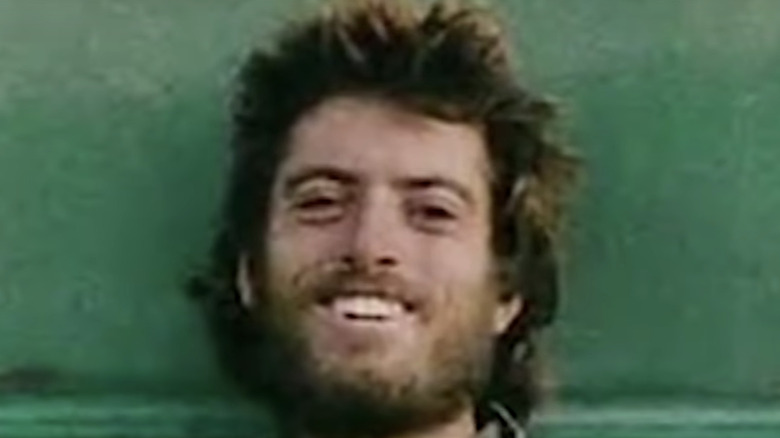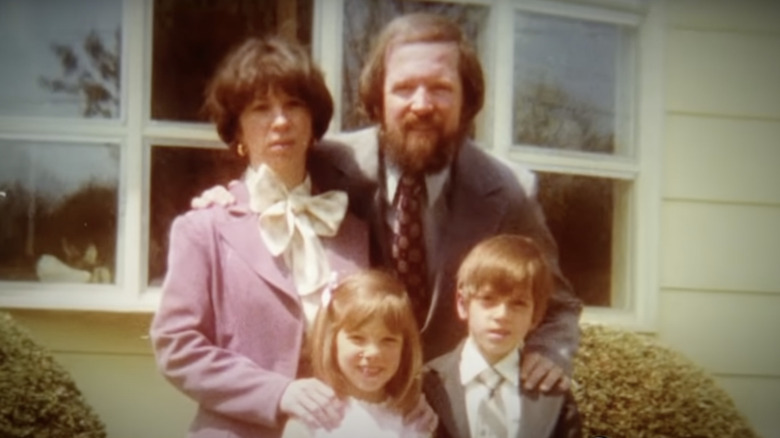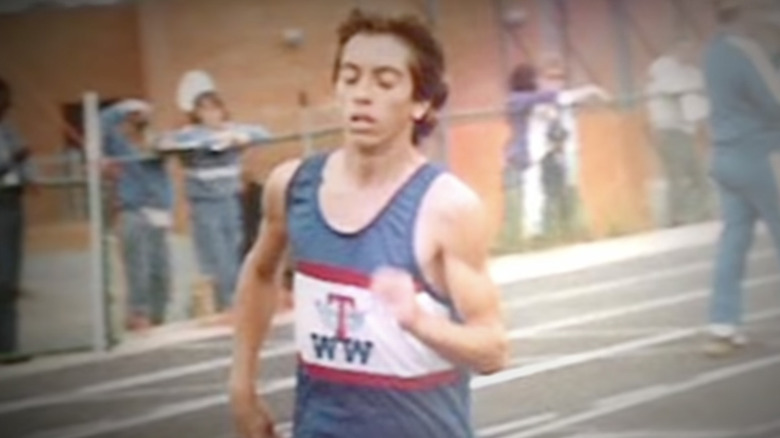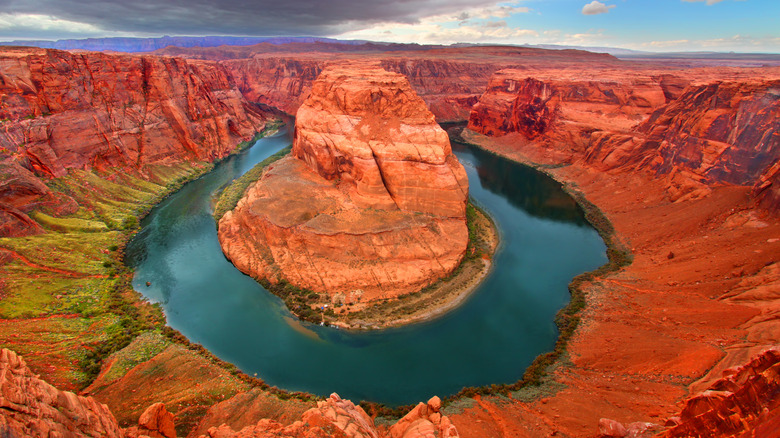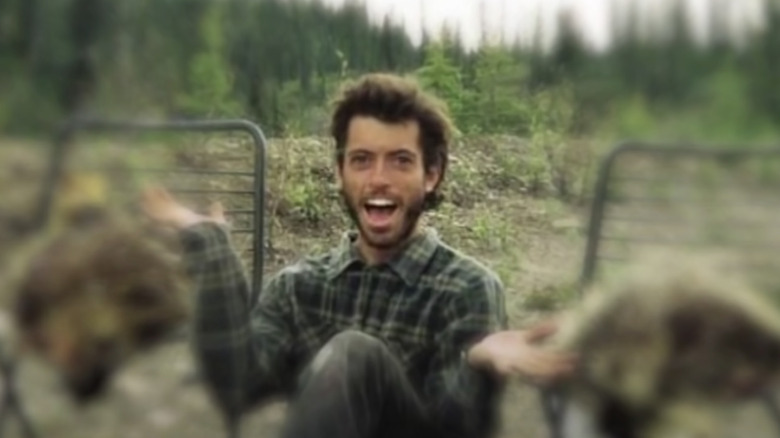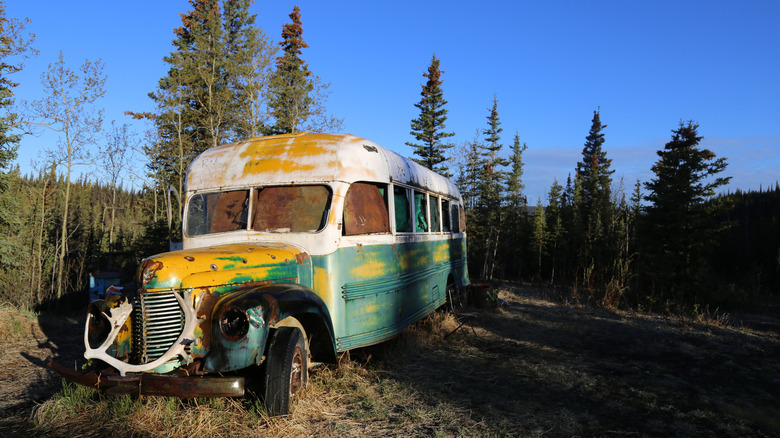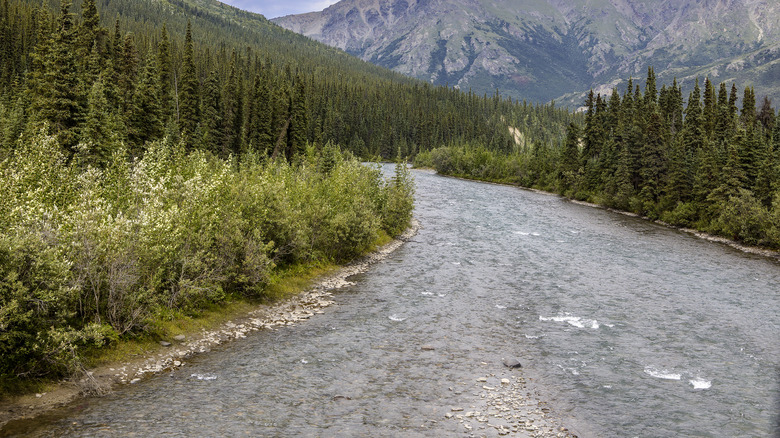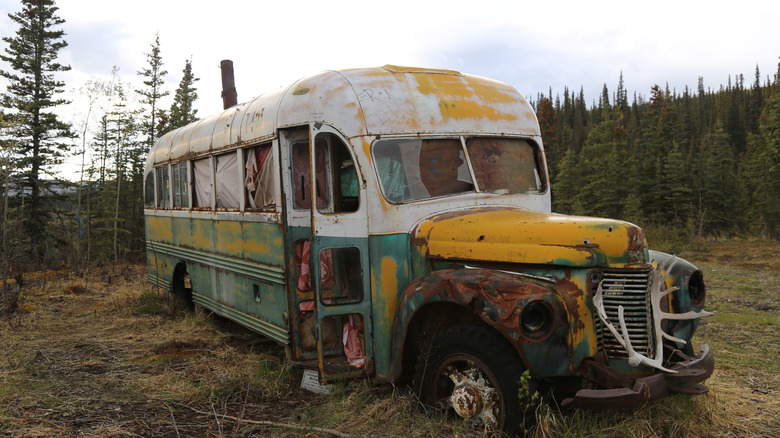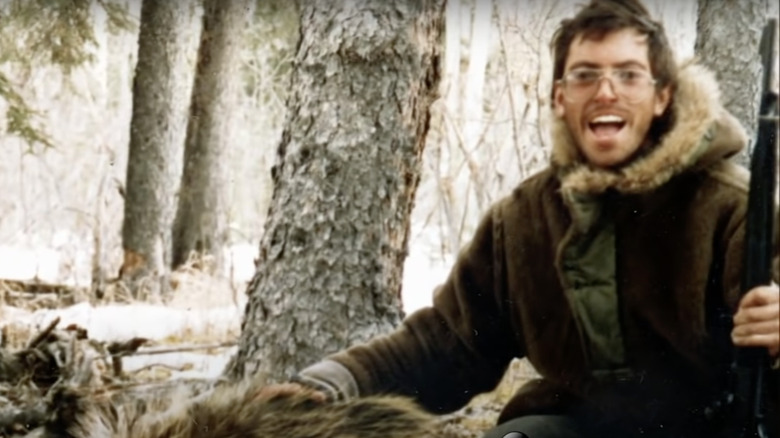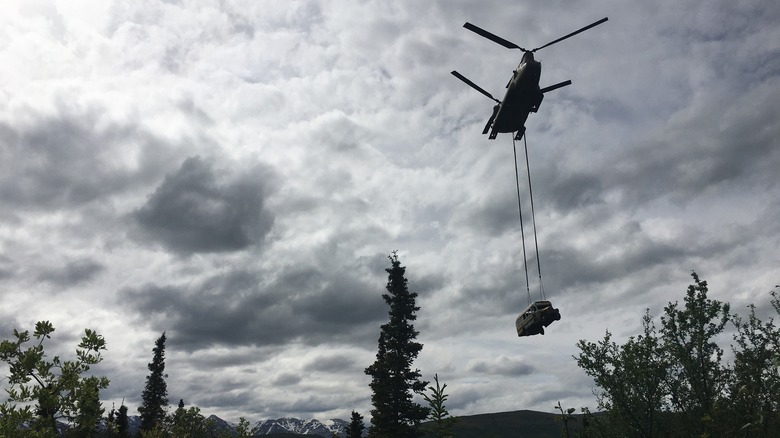The Tragic Truth About Chris McCandless
Some people become famous easily, even by accident. Others strive for fame and work tirelessly in an attempt to reach that precious place in the limelight. Unfortunately, there's also a third kind of fame — the kind that only happens when you're not around to enjoy it anymore.
Out of all the people who have become famous after their death, Christopher McCandless ranks among the strangest. Per Encyclopedia Britannica, McCandless never actively sought social glory and personal fortune. On the contrary — all he wanted was to travel the country as he wished, seeking solace outside the norms of conventional lifestyle. Despite this — or, rather, because of it — he's easily one of the better-known vagabonds in the history of the United States.
McCandless' short life took him from his native California to a great many places, thanks to his self-imposed wandering ways. In 1992, the young man made his way to Alaska, where he started hiking the Stampede Trail. A few months later, he was dead. His strange life and the events that led to his untimely demise have inspired and frustrated a great many people. Still, regardless of what you think of McCandless and his sad fate, there's no denying that his life, death, and legacy had no shortage of unfortunate events. Let's take a look at the tragic truth of Chris McCandless.
The early life of Chris McCandless
The word "wanderlust" means a "strong longing for or impulse toward wandering," per Merriam-Webster. This particular dictionary entry could easily have a picture of Chris McCandless, because the young man was pretty much defined by the term. This is all the more surprising because, according to Encyclopedia Britannica, McCandless' early life seemed like a picture-perfect re-enactment of the proverbial American Dream. A son of two well-off entrepreneurs, he was very good in school and, to an observer, appeared destined for great things.
Yet, as his sister, Carine McCandless, wrote in her book "The Wild Truth" (via Outside Online), the family could also be pretty toxic. The father, Walt, drank too much and was prone to violent outbursts. Billie, the mother, could be extremely unsupportive of her kids. There was also the matter that Walt McCandless was still married to his first wife when Carine and Chris were born, and actually led a double life with two different families for some time.
Though there was happiness in the McCandless household, this background of family drama and tragedy may very well have affected young Chris' decision to hit the road as soon as he was able to.
The birth of Alexander Supertramp
Chris McCandless may have lived his school years as a fairly ordinary guy, but as Encyclopedia Britannica tells us, he shrugged away all semblance of tradition and normalcy after he got his bachelor's degree. First, he gave away all the money he had stashed away during college. According to Anchorage Daily News, the precise sum was $24,292, and McCandless, then 22 years old (via ABC News), gave it to Oxfam.
That's a pretty hefty pile of money to donate to a charity, especially when you consider what the young man did next. Free of money and responsibilities, he left his family, drove away, and took up the identity of Alexander Supertramp. According to "Into the Wild," McCandless used the name Alexander Supertramp for years on his travels and, according to Encyclopedia Britannica, used it to sign a manifesto in which he described himself as "an extremist, an aesthetic voyager whose home is the road."
But the transition from student to transient wasn't without its difficulties. In the early stages of his journey, his car broke down in Arizona after getting stuck in a flash flood. Undeterred, the young man decided to continue his journey on foot.
Chris McCandless travels far and wide
The most famous part of Chris McCandless' travels is the final one, but, as Men's Journal notes, McCandless roamed the U.S. for a total of two years and saw many places before that final, fateful journey along the Stampede Trail. Per Encyclopedia Britannica, at one point he even navigated the Colorado River all the way to Mexico.
Sometimes, McCandless decided to take a long stop before he resumed his travels. He worked in Arizona for a while and spent some time in Salton City, California. His arguably most notorious pit stop was in Carthage, South Dakota, shortly before his canoe escapades on the Colorado River. There, he met a man called Wayne Westerberg, and worked at his grain elevator. McCandless' relationship with Westerberg proves that he wasn't living completely outside social norms. In fact, the two became good enough friends that before McCandless started his final adventure, he sent Westerberg a postcard that said he intended to go "into the wild." Both Jon Krakauer's book about McCandless and Sean Penn's movie about him use this line as their titles.
Chris McCandless hits the Stampede Trail
Chris McCandless didn't choose the Stampede Trail in the Alaskan wilderness completely at random. Even before he started his nomadic lifestyle, he'd already made a road trip to Fairbanks, Alaska, during a summer vacation, according to Encyclopedia Britannica. In his final trip, since he didn't have too many resources or a car of his own, getting there took plenty of effort — in fact, he hitchhiked all the way from South Dakota.
McCandless finally hit the trail on April 28, 1992. As Men's Journal tells us, it appears that his intention was to put his skills to a true test. As such, he set off with virtually no supplies or provisions, save for 10 pounds of rice and a small rifle. Making it in the Alaskan wilderness seemed to be a matter of some importance to him, seeing as the writings he left behind described the ordeal as a "climactic battle to kill the false being within and victoriously conclude the spiritual revolution." Unfortunately, the challenge he had imposed upon himself ended up being far too arduous for his skills and limited equipment.
Chris McCandless finds the Magic Bus
The most important visual image of Chris McCandless' sad fate is, without doubt, the bus he died in. Per CNN Travel, the vehicle that acted as McCandless' makeshift base camp during his final struggle for survival is an old International Harvester that used to serve as Fairbanks City Transit bus 142. At some point, it was decommissioned and relocated into the deep wilderness to serve as a cabin of sorts for a road construction project. Per Outside Online, the bus was dragged into the middle of nowhere by a tractor. Originally, the bus was just one of several that were retrofitted to provide temporary accommodation for workers, but the others were removed after the road project ended. Bus 142 remained where it was because of a broken axle.
According to Encyclopedia Britannica, McCandless' original intention was to keep on hiking until he reached the Bering Sea, but the plan changed after he happened to discover the bus on his travels. It was no doubt a fine headquarters for a young man in search for adventure, and McCandless called it the Magic Bus in his notes. Some have noted that the area has a pretty peculiar atmosphere, thanks to its "eerie quiet" (per Men's Journal).
Trapped and starving
As Encyclopedia Britannica explains, Chris McCandless didn't intend to disappear in the wilderness. In fact, his plan was to return to civilization in July 1992, but in the time he was in the area, the Teklanika River had expanded from a tiny creek to a life-threatening, raging river, courtesy of melting snow.
McCandless saw no way to cross the river, and apparently felt he had no choice but to continue the hunter-gatherer lifestyle and live in the bus. According to ABC News, he lived in the bus for 114 days, as gathered from his journal. Unfortunately, the food he was able to procure couldn't sustain him. As the New Yorker notes, his cause of death was determined to be starvation, though both McCandless and "Into the Wild" writer Jon Krakauer suspected that the wild potato seeds he consumed might have poisoned him. "Extremely weak," reads a note McCandless wrote three weeks before his death. "Fault of pot[ato] seed. Much trouble just to stand up. Starving. Great jeopardy."
Whether you buy into the poison theory or not, McCandless' wilderness diet was lean, comprising whatever he could forage and what small animals he managed to hunt. What's more, some have expressed the opinion that the young adventurer might not have been all that great at hunting, or at least not all that great at identifying what he killed. Per Reuters, McCandless once thought he'd killed a moose, but according to Gordon Samel — one of the hunters who found McCandless' body — it was actually a caribou. "There's a big difference between a moose and a caribou," Samel said. "A real big difference. You'd have to be pretty stupid not to be able to tell them apart."
Chris McCandless' body is found in a sorry state
As the New Yorker explains, Chris McCandless' body was found on September 6, 1992. Based on his diary markings, he'd been dead for around 19 days. Per Outside Online, the body was discovered in a sleeping bag, decomposed and emaciated.
McCandless had clearly been aware that he was in a bad way. In fact, a desperate note that he'd attached to the door of the bus outright stated that the young man was "injured, near death, and too weak to hike out of here. I am all alone, this is no joke." He also used his real name to sign the note, instead of the Alexander Supertramp moniker he'd adopted. Per the New York Times, McCandless' supplies in the bus consisted of a rifle, a camera and some film, and a bunch of books. He had used one of the books as a journal.
Starving away in a rusting bus far away from civilization seems like a tragic and fairly awful way to go, but at least there's a chance that McCandless managed to make peace with himself and his fate in the end. "I have had a happy life and thank the Lord," one of his final diary entries read, marking some of his last words. "Goodbye and may God bless you all."
McCandless becomes a cult hero
Chris McCandless chose an ascetic life of vagrancy and poverty, about as far from the limelight as one can get. Nevertheless, he became a famous figure whose tragic story is widely known. As Men's Journal tells us, McCandless' post-mortem rise from obscurity to fame involved a popular book, "Into the Wild," which was eventually turned into a Hollywood film of the same name that was directed by Sean Penn and starred Emile Hirsch as McCandless.
The reason you've heard about McCandless at all is almost certainly because of writer Jon Krakauer. Krakauer was hired to write an article about McCandless for Outside magazine, and the writer was so intrigued by the story that he ended up spending years researching McCandless. "I decided I wanted to write this book because I felt like there was a lot more to tell; there was a lot I hadn't discovered," Krakauer told the New York Times.
"Into the Wild" was published in 1996, and became a massive, though controversial success. Krakauer fully admits that McCandless' legacy is a controversial one. "He's this Rorschach test: People read into him what they see," the author has said. "Some people see an idiot, and some people see themselves. I'm the latter, for sure."
What killed Chris McCandless?
It's easy to think that Chris McCandless starved to death, considering that his normal weight was around 140 pounds, but by the time he was found, his mortal remains weighed a measly 67 pounds (per the New Yorker). Still, "Into the Wild" writer Jon Krakauer has long suspected that McCandless wasn't quite as inept a survivalist as his detractors tend to assume, and that other forces contributed to his death.
McCandless himself blamed wild potato (Hedysarum alpinum) seeds for his weakened state in the weeks before his death. Krakauer originally suspected that there may have been a mixup, and that McCandless had confused wild potato with the reportedly poisonous wild sweet pea. The writer later revised his theory and attributed the young adventurer's death to a starvation-inducing toxin known as swaisonine. In 2007, however, this theory was completely and utterly debunked by biochemist Thomas Clausen, who tested wild potato seeds for potentially harmful stuff and found none.
In 2013, Krakauer introduced another theory about McCandless' possibly potato seed-induced death, based on research by Ronald Hamilton. This version indicates that the reason behind McCandless' weakened state could be a neurotoxin known as ODAP, which, according to Hamilton, can weaken and even paralyze young men in conditions similar to McCandless'. In 2015, the writer was involved in a study that suggested an amino acid called L-canavanine could be the culprit (via Science Direct).
The case against Chris McCandless
Chris McCandless' life and death have developed a bit of a legacy, but many people remain unimpressed by his story and feel that he shouldn't be considered an idol. As Treehugger points out, the story of Alexander Supertramp draws plenty of opinions both for and against, and his most vocal critics aren't afraid to make their opinions known. Writer Craig Medred of Anchorage Daily News has outright called McCandless a "thief" and a "bum," along with other descriptions along those lines. Medred has also noted that McCandless committed certain unsavory acts during his travels, such as breaking into a cabin to steal food.
Per Men's Journal, the general sentiment in Alaska appears to be that McCandless was basically just an inexperienced kid who tried to brave the wilderness with a woeful lack of gear and survival skills. Hunting guide Brent Keith has pointed out some of the more severe mistakes McCandless made in his final weeks. "I just don't get why he didn't stay down by the Teklanika until the water got low enough to cross. Or walk upstream to where it braids out in shallow channels. Or start a signal fire on a gravel bar." It's certainly true that McCandless doesn't appear to have explored the river bank too much — he reportedly failed to locate a relatively nearby hand-operated tram that would have enabled him to cross the river with ease.
The deadly legacy of Bus 142
As Jon Krakauer's book became successful, and Chris McCandless' story got out there, the notoriety of the wanderer's final months started living a life of its own. Per Treehugger, many people were so moved by the story that they actually started hiking to the site of Bus 142, and over the years, the deteriorating vehicle saw more and more foot traffic from devoted McCandless fans. Things got so bad that the people in the area started calling these travelers "McCandless pilgrims," and their numbers could exceed 100 per year.
The problem, of course, is that the trail between the bus and civilization hasn't gotten any less dangerous after McCandless' death. The Teklanika River can still be incredibly difficult to cross, and, as the BBC notes, the authorities have had to rescue many pilgrims. Two people even died trying to reach the site. In 2020, the state of Alaska finally decide that enough was enough. The bus was clearly important to many people, but since it was attracting people to dangerous situations, it was clear that something had to change.
The solution was an impressive one: The bus was airlifted from its precarious position in the wilderness and transported to a less perilous location. According to Backpacker, Bus 142 is set to receive a new home as the centerpiece of an exhibition at the University of Alaska's Museum of the North, in Fairbanks.
